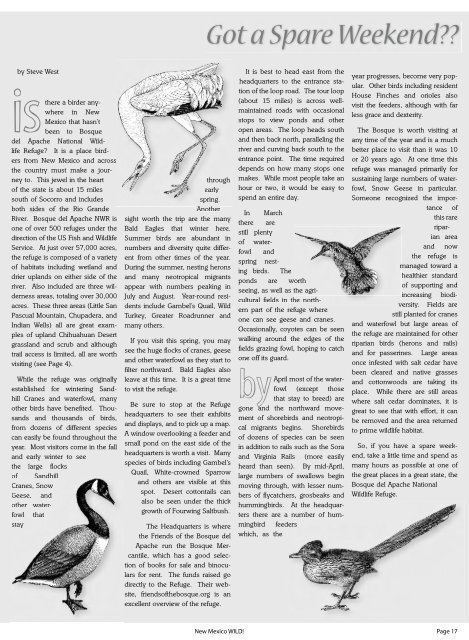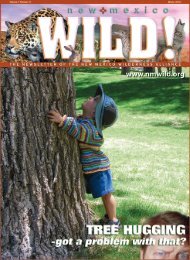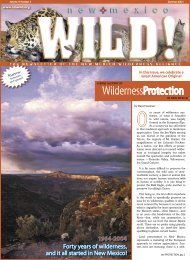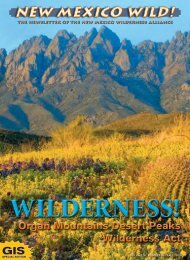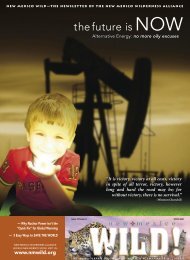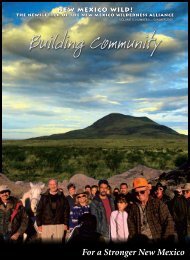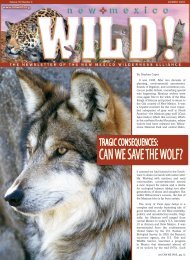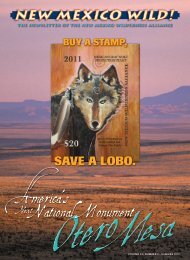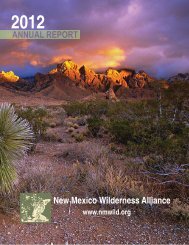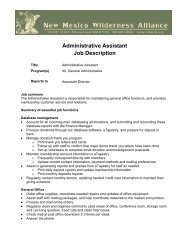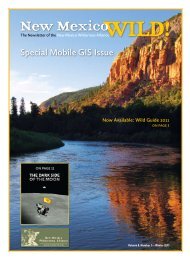FIGHTING THE GOOD FIGHT - New Mexico Wilderness Alliance
FIGHTING THE GOOD FIGHT - New Mexico Wilderness Alliance
FIGHTING THE GOOD FIGHT - New Mexico Wilderness Alliance
Create successful ePaper yourself
Turn your PDF publications into a flip-book with our unique Google optimized e-Paper software.
Got a Spare Weekend??<br />
by Steve West<br />
is<br />
there a birder anywhere<br />
in <strong>New</strong><br />
<strong>Mexico</strong> that hasn’t<br />
been to Bosque<br />
del Apache National Wildlife<br />
Refuge? It is a place bird-<br />
ers from <strong>New</strong> <strong>Mexico</strong> and across<br />
the country must make a journey<br />
to. This jewel in the heart<br />
of the state is about 15 miles<br />
south of Socorro and includes<br />
both sides of the Rio Grande<br />
River. Bosque del Apache NWR is<br />
one of over 500 refuges under the<br />
direction of the US Fish and Wildlife<br />
Service. At just over 57,000 acres,<br />
the refuge is composed of a variety<br />
of habitats including wetland and<br />
drier uplands on either side of the<br />
river. Also included are three wilderness<br />
areas, totaling over 30,000<br />
acres. These three areas (Little San<br />
Pascual Mountain, Chupadera, and<br />
Indian Wells) all are great examples<br />
of upland Chihuahuan Desert<br />
grassland and scrub and although<br />
trail access is limited, all are worth<br />
visiting (see Page 4).<br />
While the refuge was originally<br />
established for wintering Sandhill<br />
Cranes and waterfowl, many<br />
other birds have benefi ted. Thousands<br />
and thousands of birds,<br />
from dozens of different species<br />
can easily be found throughout the<br />
year. Most visitors come in the fall<br />
and early winter to see<br />
the large fl ocks<br />
of<br />
Sandhill<br />
Cranes, Snow<br />
Geese, and<br />
other waterfowl<br />
that<br />
stay<br />
through<br />
early<br />
spring.<br />
Another<br />
sight worth the trip are the many<br />
Bald Eagles that winter here.<br />
Summer birds are abundant in<br />
numbers and diversity quite different<br />
from other times of the year.<br />
During the summer, nesting herons<br />
and many neotropical migrants<br />
appear with numbers peaking in<br />
July and August. Year-round residents<br />
include Gambel’s Quail, Wild<br />
Turkey, Greater Roadrunner and<br />
many others.<br />
If you visit this spring, you may<br />
see the huge fl ocks of cranes, geese<br />
and other waterfowl as they start to<br />
fi lter northward. Bald Eagles also<br />
leave at this time. It is a great time<br />
to visit the refuge.<br />
Be sure to stop at the Refuge<br />
headquarters to see their exhibits<br />
and displays, and to pick up a map.<br />
A window overlooking a feeder and<br />
small pond on the east side of the<br />
headquarters is worth a visit. Many<br />
species of birds including Gambel’s<br />
Quail, White-crowned Sparrow<br />
and others are visible at this<br />
spot. Desert cottontails can<br />
also be seen under the thick<br />
growth of Fourwing Saltbush.<br />
The Headquarters is where<br />
the Friends of the Bosque del<br />
Apache run the Bosque Mercantile,<br />
which has a good selection<br />
of books for sale and binoculars<br />
for rent. The funds raised go<br />
directly to the Refuge. Their website,<br />
friendsofthebosque.org is an<br />
excellent overview of the refuge.<br />
It is best to head east from the<br />
headquarters to the entrance station<br />
of the loop road. The tour loop<br />
(about 15 miles) is across wellmaintained<br />
roads with occasional<br />
stops to view ponds and other<br />
open areas. The loop heads south<br />
and then back north, paralleling the<br />
river and curving back south to the<br />
entrance point. The time required<br />
depends on how many stops one<br />
makes. While most people take an<br />
hour or two, it would be easy to<br />
spend an entire day.<br />
In March<br />
there are<br />
still plenty<br />
of waterfowl<br />
and<br />
spring nesting<br />
birds. The<br />
ponds are worth<br />
seeing, as well as the agriern<br />
cultural fields in the north-<br />
part of the refuge where<br />
one can see geese and cranes.<br />
Occasionally, coyotes can be seen<br />
walking around the edges of the<br />
fi elds grazing fowl, hoping to catch<br />
one off its guard.<br />
by<br />
April most of the waterfowl<br />
(except those<br />
that stay to breed) are<br />
gone and the northward movement<br />
of shorebirds and neotropical<br />
migrants begins. Shorebirds<br />
of dozens of species can be seen<br />
in addition to rails such as the Sora<br />
and Virginia Rails (more easily<br />
heard than seen). By mid-April,<br />
large numbers of swallows begin<br />
moving through, with lesser numbers<br />
of fl ycatchers, grosbeaks and<br />
hummingbirds. At the headquarters<br />
there are a number of hummingbird<br />
feeders<br />
which, as the<br />
year progresses, become very popular.<br />
Other birds including resident<br />
House Finches and orioles also<br />
visit the feeders, although with far<br />
less grace and dexterity.<br />
The Bosque is worth visiting at<br />
any time of the year and is a much<br />
better place to visit than it was 10<br />
or 20 years ago. At one time this<br />
refuge was managed primarily for<br />
sustaining large numbers of waterfowl,<br />
Snow Geese in particular.<br />
Someone recognized the importance<br />
of<br />
this rare<br />
riparian<br />
area<br />
and now<br />
the refuge is<br />
managed toward a<br />
healthier standard<br />
of supporting and<br />
increasing<br />
biodiversity.<br />
Fields are<br />
still planted for cranes<br />
and waterfowl but large areas of<br />
the refuge are maintained for other<br />
riparian birds (herons and rails)<br />
and for passerines. Large areas<br />
once infested with salt cedar have<br />
been cleared and native grasses<br />
and cottonwoods are taking its<br />
place. While there are still areas<br />
where salt cedar dominates, it is<br />
great to see that with effort, it can<br />
be removed and the area returned<br />
to prime wildlife habitat.<br />
So, if you have a spare weekend,<br />
take a little time and spend as<br />
many hours as possible at one of<br />
the great places in a great state, the<br />
Bosque del Apache National<br />
Wildlife Refuge.<br />
<strong>New</strong> <strong>Mexico</strong> WILD!<br />
Page 17


